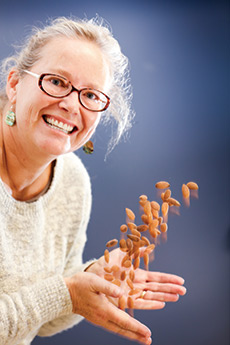Almonds blossoming

Dr Michelle Wirthensohn Virtually no-one outside the almond industry blinked when Australia overtook Spain as the world’s number two exporter last year. But South Australians certainly should have taken notice, with the humble nut set to join the olive and the grape as a great new cash crop for the State.
This year’s crop is expected to top out at a record 75,000 tonnes, with room for growth as international demand expands. This is due to the ongoing drought reducing California’s yield, which normally accounts for 80 per cent of world output.
The $370 million almond export industry is already a second-generation success in South Australia, with growers expanding from original plantations around ÐÂÀ˲ÊƱ into the Riverland. And it is likely to grow faster and further, if research led by the University to create an almond that is especially suited to Australia succeeds.
Almonds are a good source of protein, plus Vitamin E, heart disease risk-reducing monounsaturated fat and dietary fibre. Almond meal also meets the increasing market gluten-free foods. Recent US research also points to the almond’s potential in preventing the onset of diabetes. “Almonds are the quiet achiever of horticulture,” says Dr Michelle Wirthensohn, Horticulture Innovation Australia Research Fellow at the University’s Waite Research Institute.
Also in the pipeline is a research project on almond waste, investigating the use the shell in cancer treatment and as an organic feed additive for fish and abalone.
It’s why Dr Wirthensohn, by her own admission, “lives and breathes almonds”—she is currently working to discover if new tree breeds can create a super SA nut. “At the moment there are only three cultivars, so we need to develop more for long-term sustainability,” she says. Of the five varieties in large-scale trials in the Riverland and Sunraysia regions, three are self-fertile, which could be a very big deal indeed for growers.
Many commercial cult | 
